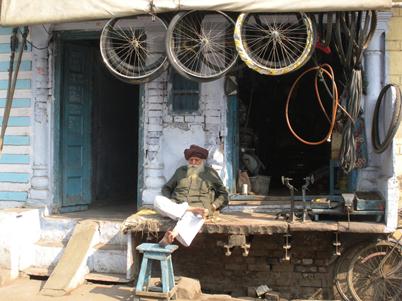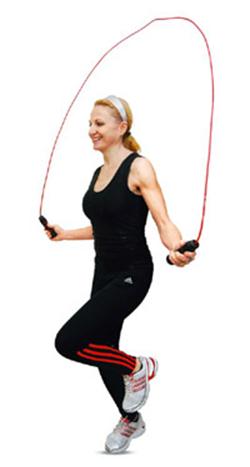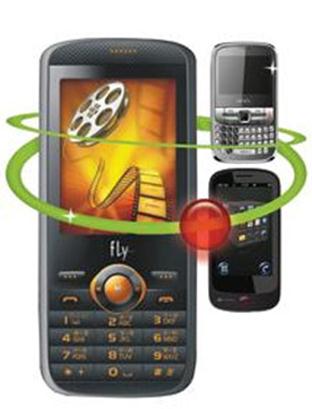 |
| Afternoon Siesta |
 |
| Gutka gluttons |
 |
| Nights of desire |
 |
| Shave on streets |
 |
| Allah for afternoon |
 |
| Knitting in technicolor |
 |
| Old-age tenants |
 |
| Flowing juices |
 |
| Hostel for pigeons |
 |
| View from the top |
 |
| Broken dreams |
 |
| Colourful starts |
 |
| In anticipation |
 |
| Barati’s bane |
 |
| Where’s the postman? |
Express Workouts
Bid your flabby body goodbye. Our celebrity fitness experts create 10- to 15-minute workouts with one aim in mind: a fab body for you in 2011. By Shweta Taneja
“All you need is 15-20 minutes of any hot and sweaty exercise to keep yourself fit,” says Delhi-based Reebok fitness trainer Nisha Varma. If it is tough for you to work out during the week, “make up on weekends with a 45-minute session of walking, jogging, swimming, cycling or dancing”.
Our fitness experts understand that many of you can’t take an hour out of your busy schedules every day, so they have created made-to-order workouts which will take less than 20 minutes a day to get you into a fab shape. “The idea is to be regular at the regime you pick up and do it every day,” says Mumbai-based yoga expert Tonia Clark, who believes a lot can be achieved if you make sure you exercise for at least 15 minutes early in the morning daily. “You can easily get a total body workout, body stretch as well as peace of mind,” she says. Here’s what you can do.
YOUR 2011 RESOLUTION: Tone arms, shoulders and strengthen neck muscles
OUR EXPERT: Nisha Varma, a Reebok master trainer and fitness expert based in Delhi who has authored ‘Yoga for Back Problems’ and ‘Yoga at the Work Place’, says simple strength training two days a week can tone up arms and shoulders.
WHAT SHE SAYS
You won’t see a significant difference in your body but yes, the chicken wings will disappear. You will need a pair of dumb-bells of a weight that is a challenge for you (should be at least 1kg).
HER WORKOUT
•Bicep curls: Stand with feet shoulder-width apart and hold one dumb-bell in either hand. Lift the dumb-bell towards your shoulders as you exhale. Lower it slowly to starting position as you exhale. Make sure you maintain the correct posture through the full range of movement. Alternate hands and do one set of 20 reps.
•Triceps extension: Stand with legs shoulder-width apart, belly in and shoulders pulled back and down. Hold the rod of one dumb-bell with both hands and lift it behind your shoulders in the middle of your upper back. Your elbows point towards the ceiling, arms are close to ears and the dumb-bell is resting between your shoulder blades. Exhale, lifting the dumb-bell towards the ceiling. Lower the arms slowly as you inhale. Do one set of 20 reps.
•Shoulder front raise: Hold a dumb-bell in each hand. Stand with legs shoulder-width apart. Lift both arms forward till shoulder level as you exhale and lower the arms as you inhale. Do not drop the arms suddenly. Do one set of 20 reps.
•Shoulder lateral raise: Hold a dumb-bell in each hand. Lift both arms to the side of your body till shoulder level. Inhale as you lift and exhale as you lower the weights.
•Finish the session with shoulder rotations forward and back eight times each.
A WORD OF CAUTION
Warm-up is a must before any exercise programme. You also need appropriate shoes and apparel. Before you begin, get a basic medical check-up.
 YOUR 2011 RESOLUTION: I want to strengthen my heart
YOUR 2011 RESOLUTION: I want to strengthen my heart
OUR EXPERT: Vesna Jacob, a Pilates expert based in Delhi who runs Hypoxis, a wellness clinic.
WHAT SHE SAYS
There are many ways to improve your cardiac health. Walking, jogging, running or hopping are some of them. But if you haven’t done cardio for a while, you will need to start small. Skipping rope is the most fun as well as effective way to tone up the entire body. Build up your stamina by starting slow and sticking to the routine regularly. You can increase the number of sets (maximum, four) per session as you build your stamina.
HER WORKOUT
• Start with a couple of minutes of good warm-up and stretching. This will make sure that you don’t strain or pull your muscles.
•Stage 1: Keep an even tempo of skipping throughout the workout, and finish off at a faster pace. Do this for cycles of 5 minutes.
•Stage 2: A couple of weeks into this regimen, change this to interval training: Follow a 30-second fast and 60-second slower skipping rhythm in cycles of 5 minutes.
•Stage 3: The next stage is to do 30 seconds fast, 30 seconds slow, and then 60 seconds fast, 30 seconds slow, and so on for cycles of 5 minutes.
A WORD OF CAUTION
If you have to gasp for air or feel dizzy, or experience any chest pain, you need to stop immediately and have yourself checked by a doctor.
YOUR 2011 RESOLUTION: Lose the beer belly
OUR EXPERT: Manish Tiwari, who teaches yoga to celebs such as Katrina Kaif and Sridevi, at his gym Cosmic Fusion, Bandra, Mumbai.
WHAT HE SAYS
A beer belly is a direct result of the excessive sugar in your diet. Ideally cut down on the consumption of beer. In case you still feel like having beer, remember to have darker beer as that’s richer in nutrients and antioxidants and has lesser sugar content.
HIS WORKOUT
•Shalabhasana: Lie flat on your stomach with your legs together, hands by the side of the body. Now raise your arms, chest, head and legs simultaneously, and hold for about 2-5 seconds. Then lower. This engages your abs fully.
•Setubandhasana: Lie flat on your back with your knees bent and your feet apart. Place your arms flat on your side, and lift your hips and back off the floor while leaving your head, shoulders and feet on the floor. Hold for about 5-10 seconds and do 10-15 reps. This burns your belly fat.
•Yoga crunches: Finally finish off with some yoga crunches. Lie down on your back, put your hands behind your head to support your back and using your abdominal muscles, push your legs up towards the ceiling, lifting your buttocks about 2-3 inches off the ground. Do 15-20 reps about three times a week.
A WORD OF CAUTION
Be careful when doing these poses if you don’t have any earlier yoga experience. You could injure yourself. Go slow on each one and keep breathing normally.
YOUR 2011 RESOLUTION: A speedy total body workout
OUR EXPERT: Tonia Clark, a yoga expert from Canada who is based in Mumbai and has worked on a DVD with Lara Dutta called ‘Yoga Recovery and Rejuvenation’.
WHAT SHE SAYS
Start with a Surya Namaskar or Sun Salutation, which is a full body warm-up of 12 asanas. Do five to start with and follow with the workout listed below. This will cleanse your body, give you a nice stretch and soothe your mind.
HER WORKOUT
•Vrikshasana: Shift the weight to the left leg. Lift your right foot above the left knee, pushing the sole of the right foot into the left thigh. Bring your hands into prayer position. Shoulders relaxed, jaw soft and gaze fixed on one point, inhale and raise arms up to the sky. Hold the pose for at least five full cycles of breath.
•Pawanmuktasana: Lie on your back, legs straight out. Bend your right knee into your chest and hug your thigh, holding it with your arms. Pull the knee towards the right shoulder, keeping the left leg active. Feel a pinch in the right hip crease. This will open up the hips, cleanse your digestive system and eliminate toxins.
•Shavasana: Lie on your back with your legs straight and apart, your feet relaxed. Place your arms alongside your body, a little away, palms facing up. Roll your shoulder blades in towards each other. Close your eyes and just be still, breathing deeply and relaxing.
A WORD OF CAUTION
First train with a yoga teacher.
For the complete story, click here.
Same sex feminism
Let me not ramble on the concept, but show you what happens. Friend A and Friend B meet after a long time. Both have been college mates and are in their late 20s or 30s.
‘Where are you working now?’ asks friend A; trying to make friendly conversation.
‘Oh, I am doing nothing. Family takes up all my time,’ answers friend B vaguely.
‘Oh, you left your job?’ asks friend A.
‘Yes, I couldn’t take the stress of taking care of a child/home/husband/in laws and working,’ says friend B now, her eyes flitting uncomfortably from one side to another.
‘But, B! You have to take control of your life! You cannot sacrifice your needs, yourself for your family! They will have to adjust,’ says friend A, concerned, proudly single, living alone in a two bedroom apartment and earning in lakhs.
Friend B looks at the table corner, trying to find a flint of dirt there and feeling that her life sucks.
Of course you would have figured out that the conversation is between two females (I really don’t see men asking these questions of each other or even being concerned about this–tell me if I am wrong). Friend A is a traditional feminist, with a successful career and a ‘living for myself’ mantra. Friend B represents everything the traditional feminists protest against—family bindings, sacrifice, traditional woman roles. They are of the same age.
 But this blog is not about who’s wrong or who’s right. That would be belittling both their choices. This is about how women are the ones expecting women to fit into an idea of feminist role or into an idea of traditional role. It’s not the men. We don’t need them there. Women are the protectors and keepers of roles—be it traditional or liberated roles.
But this blog is not about who’s wrong or who’s right. That would be belittling both their choices. This is about how women are the ones expecting women to fit into an idea of feminist role or into an idea of traditional role. It’s not the men. We don’t need them there. Women are the protectors and keepers of roles—be it traditional or liberated roles.
Traditionally (and still), it was the mother/mother-in-law figure who ensured that the girl would play a certain role. The elder woman is in this way a spokesperson for our patriarchal society—for the roles set for women, for decorum, for morality. (Beautiful shown by this old National Geographic cover.)
Feminism was a protest against these traditional roles in society. The women wanted equality, the women wanted to be the superior sex, the women wanted to work outside and to have freedom of choice. Some years (or decades, depending on which country /area you see) down the lines, feminism has made itself a ‘role’, a comfortable box, to live in. The definition varies, but not that much. It’s defined as exact opposite of the traditional role of women. If you don’t work, you are not a feminist. If you sacrifice your happiness for your family, you are not a feminist. If you wear a bra, you are not a feminist. If you dress sexy, you are not a feminist. If you leave a job and have babies, you are not a feminist. If you don’t distrust men, you are not a feminist. If you do a man’s cleaning, you are not a feminist. If you work in the kitchen, you are not a feminist. Somehow, feminism is defined by all the things that you should or shouldn’t do.
And ironically, it is we, the ‘liberated’ women living in urban cities who are trying to put these boxes on our gal pals, our cousins, our sisters—same age females—and make a judgment on them. Again, no men, if you notice.
I have been on both ends of the conversation. I have played the role of Friend A as well as Friend B. But then I wonder. Shouldn’t feminism be something that just lets you be whatever you choose to be? That doesn’t have rules? Isn’t it about freedom of choice?
Oh, there are loads of disclaimers for the terms used in this blog, but maybe I will leave it open to criticism. Suicide I know, but well.
Two’s company
Ditch your multiple handsets for a sleek, popular dual-SIM cellphone, but be wary of dubious build quality. By Shweta Taneja & Krish Raghav
Three years ago, Mumbai-based entrepreneur Anun Charan decided to separate the phone numbers he needs for work from his personal contacts. Since he hated carrying more than one phone at a time, he bought a phone that could support two SIM cards.
“At that time, the only choice I had was to buy a cheap Chinese handset,” he says. Some months ago, when Nokia C2 was launched, Charan discarded his phone for the sturdy Nokia model. “Competitive network costs may be a factor while considering dual-SIM phones but the real plus is convenience. No two handsets, no two chargers and no two ringtones,” he says.
Delhi-based entrepreneur Rajesh Makkarhad is a frequent flyer who has to travel to Europe and the US for work. For him, swapping SIMs constantly and keeping at least one small rectangle safe and secure in his wallet at all times was a cumbersome exercise. “Nothing sucks more than constantly changing SIM cards in every continent,” he says. Samsung’s announcement of the launch of its Star Duos line of dual-SIM phones last month came to his rescue.
“Dual-SIM phones have been the latent need of Indian consumers, which MNC brands could not recognize,” says Gaurang Singh, senior editor, www.teleguru.in, a group of mobile experts who talk about the latest in the market.
The demand for dual-SIM phones is reflected in a study conducted by market intelligence and advisory firm IDC (International Data Corporation). India Quarterly Mobile Handsets Tracker, September 2010 says dual-SIM card slot phones have grown to touch as much as 38.5% of the total India mobile handset shipments, from less than 1% in the April-June 2009 quarter. Most of these phones, however, are offered at throwaway prices and are of dubious build quality.
“Dual-SIM phones also give customers an option to choose the best offer from service providers, which are coming in every month,” says Varun Krish, founder and editor of www.fonearena. com, a website that reviews cellphones. According to Singh, more phones are going to be launched in this category. “There’s a gap in the high end, smartphone category. There are just one or two phones up there, so there’s place for much more variety,” he says.
With new handsets being launched every month, and nearly 30 new mobile brands jostling for attention, here is a quick guide for those considering a dual-SIM phone.

Wynncom Y23
A small, stylish phone, the Y23 is made for someone who doesn’t have easy PC access. It comes with two SD card slots that support expandable memory up to 8 GB (4 GB + 4 GB). This makes it easier for the user to transfer data from one memory card to the other, without the need for another device. Other than this, it has the usual specs—FM, music, video player and camera, as well as practical features such as a torchlight and USB port.
Price: Rs. 1,600*
What we like: A great entry-level phone for this category.
Nokia C2
This is a long-awaited dual-SIM from Nokia with dual standby and a hot-swappable secondary SIM slot. This means the second SIM can be removed and inserted while the handset is still running. It’s ideal for any Nokia loyalist looking for a functional phone high on usability.The phone comes loaded with Ovi Mail, a free email tool that can be synced to multiple email addresses, and Ovi Life, another tool that provides information on healthcare, agriculture, education and entertainment. The memory capacity can be expanded up to 32 GB using Micro SD cards.
Price:Rs. 2,500*
What we like: It’s the usual Nokia—sturdy, reliable, durable, and with good after-sales service.
Aroma D110
Aroma is among the many new mobile brands offering basic value-for-money phones. At a throwaway price, the phone offers you a 2.4-inch 262K colour QVGA sharp display, a 1.3- megapixel camera, preloaded games, a multi-format music player and FM radio with recording. Add to that a video player, voice recorder and Facebook and MSN messenger applications and you have a nice, cheap substitute for a fully loaded feature phone. An expandable memory capacity of 2 GB takes care of all the additional things you would like to keep on the phone.
Price: Rs. 2,699*
What we like: Value for money and stylish to look at.
 Fly MV135
Fly MV135
It’s a basic handset that is strong on the entertainment factor, with a 2-megapixel camera, FM recording and an eBook reader. It offers Nimbuzz, Opera Mini and Snaptu for social addicts, as well as a few Java games. It includes a few nifty features such as call recording and call blacklisting, useful for those who might receive a lot of unsolicited calls (i.e, everyone). You can connect it through USB and Bluetooth with other devices.
Price: Rs. 3,949*
What we like: Good music options, including scheduled recording from radio as well as an equalizer.
Micromax X550 Qube
A stylish 3D interface in its 3.2-inch, touch-screen display makes it quite unique, though it tends to lag quite a bit. Other than that it has the usual 2-megapixel camera, stereo FM radio, a multi-format music player and video player. It is preloaded with Opera Mini mobile browser and social networking applications such as Facebook, Nimbuzz and Snaptu.
Price: Rs. 4,800*
What we like: Fun interface with 8 hours of talktime and six days of standby time for people who forget to charge their phones.
MVL G81
With a local push-mail service offer, it’s one of the basic business phones available in this category. This lightweight phone comes with a 2.4-inch colour display, a Qwerty keypad, a 3.2-megapixel camera, Quadband and FM radio with recording. The device offers Java, Bluetooth, with A2DP and EDGE connectivity. Its speed connectivity and Opera Mini, Nimbuzz and Snaptu apps make it a good choice for online addicts. You can store 2,000 phonebook contacts and 1,000 SMS entries. Featuring a mobile tracker, the device works well as a modem and allows PC sync support as well. Considered a common man’s smartphone.
Price: Rs. 4,500*
What we like: Its generous, Internet-supported attributes and push-mail service offer.
Motorola EX128
Launched earlier this month, EX128 is a value-for-money touch-screen model with a 3.2-inch large WQVGA display and a screen resolution of 240×400 pixels. Entertainment-wise, the phone offers a 3-megapixel camera, a video player and quick access to Gmail/Facebook/MySpace/YouTube. It’s good for music freaks as a huge library can be created in 32 GB expandable memory, the 3.5 mm jack gives you universal connectivity and long battery life ensures long hours of listening without interruption.
Price: Rs. 5,749*
What we like: A good balance between connectivity, entertainment and usability.
Karbonn K1212
This basic 3.2-inch touch screen is a nice overall package. The audio player features a CD-player-like interface, and plays all the standard formats. It even allows you to become DJ by pushing, pulling and rotating on on-screen disk. Entertaining, if purely decorative. You can also shake the phone to change songs and wallpapers and listen to stereo music wirelessly via a Bluetooth headset. Other than that, it comes with a 3-megapixel camera and quick access to social networking sites such as Facebook, Twitter, eMSN and eBuddy. There is also a built-in data/fax modem.
Price: Rs. 5,100*
What we like: It’s sleek, value for money and fun to use, especially for music.
Samsung Star Duo B7722
There’s no smartphone in the dual-SIM market, but the Samsung B7722 comes close. The phone offers a 3.2-inch, touch-screen display with support for 262K colours. It gives up to 12 hours of talktime and uses both the SIMs for a unique 3G + 2G (HSDPA + EDGE) dual standby to expand communication networks. EDGE allows for faster downloads and file transfers while the HSDPA network connection is used to conveniently update status, upload photos and send messages through social networking sites. The handset comes loaded with a 5-megapixel camera with Power LED flash, video-recording capabilities, social networking widgets, a FindMusic service to identify songs, Document viewer, Stereo FM radio and recording. It has 250 MB internal memory, expandable to 16 GB with an SD card.
Price: Rs. 12,300*
What we like: Best battery time of 12 hours talktime, with a smooth touch screen and faster Internet browsing. Plus, it supports nine Indian languages.
* Prices listed are approximate.
For complete story, click here.
The slow killer called sitting
Studies suggest that even if you exercise for 30 minutes daily, you are prone to heart disease and spinal problems if you spend a large part of your day sitting. By Shweta Taneja
Rakesh Mehta, a 32-year-old business manager with a consultancy, spends most of his workday attending meetings, taking calls and writing instructions through emails, all sitting in his office. Once at home, he watches TV before going to bed. In a day, he spends around 8 hours sleeping, 2 hours standing or walking from one place to another, about half-an-hour exercising and the remaining 13-odd hours sitting.
 Don’t be surprised if your own calculations throw up similar results. Like Mehta, most of us belong to a generation of sitters, thanks to technology’s little conveniences. “Most of us spend almost 95% of our waking hours sitting,” says Marc Hamilton, professor at the Pennington Biomedical Research Center, US, in an email interview. He labels today’s generation as “active couch potatoes”, and those who manage the required 30 minutes of exercise everyday as “exercising couch potatoes”. His papers, published in journals such as Diabetes (2007) and Current Cardiovascular Risk Reports (2008), show how excessive sitting time is harmful to cardiovascular and metabolic effects. This can lead to lifestyle diseases such as hypertension, cardiovascular diseases, obesity, type 2 diabetes, heart attacks, and some cancers, irrespective of the time you spend exercising.
Don’t be surprised if your own calculations throw up similar results. Like Mehta, most of us belong to a generation of sitters, thanks to technology’s little conveniences. “Most of us spend almost 95% of our waking hours sitting,” says Marc Hamilton, professor at the Pennington Biomedical Research Center, US, in an email interview. He labels today’s generation as “active couch potatoes”, and those who manage the required 30 minutes of exercise everyday as “exercising couch potatoes”. His papers, published in journals such as Diabetes (2007) and Current Cardiovascular Risk Reports (2008), show how excessive sitting time is harmful to cardiovascular and metabolic effects. This can lead to lifestyle diseases such as hypertension, cardiovascular diseases, obesity, type 2 diabetes, heart attacks, and some cancers, irrespective of the time you spend exercising.
Hamilton’s research, which is supported by a growing body of research into a concept called inactivity physiology, is trying to establish a link between disease and sedentary behaviour or prolonged sitting. “It’s a new way of thinking about physical inactivity or our sedentary lifestyle,” says Hamilton.
According to a study of 8,800 adults published in January in Circulation: Journal of the American Heart Association, for every 60 minutes you sit watching TV daily, you may increase your risk of early death from cardiovascular disease and cancer. Inactivity just doesn’t suit humans, according to Hamilton. “The enzyme LPL (lipoprotein lipase), which usually acts like a vacuum cleaner and sucks up the bad fat in your blood and converts it into muscle, shuts down when you are sitting or lounging,” he explains. It’s like our body’s good workers go idle when we are sitting, so more fat stays in the blood and starts getting deposited in the belly fat and other organs. “When you are inactive for a prolonged period, your muscles become placid and lose their tautness. You also tend to gain weight, especially in the midriff area,” says Sanjay Mehrotra, senior consultant cardiologist, Narayana Hrudayalaya Hospital, Bangalore. The fat which gets collected in the central part of your body, starts behaving like an endocrine gland, he says. It secretes hormones which lead to an increase in artery-damaging fat in the blood, causing obesity, hypertension and diabetes.
Back problems
Other than the heart, your back, spine, shoulders and hips develop problems due to prolonged sitting. “Your spine is made to stand. When you sit for longer hours, to be in a perfect posture with a straight back, you need very strong back muscles,” says Shiv Kanwat, consultant, physiotherapy, Moolchand Orthopaedics Hospital, New Delhi, who gets many patients who are in their early 20s and mid-30s with neck, lower back or shoulder complaints. And since most people do not have very strong back muscles, they tend to slouch after long hours of sitting, leading to the lower back slouching forward and shoulders drooping. Over time, this leads to pain in the shoulders, neck and lower back.
Computer table too low?
The problem is multiplied because ergonomics is not something most Indian firms include in their priority list. Bhavna Popat, 28, developed lower back pain after just a couple of years of working in a call centre. “The chair at my office was the problem; it was just too straight,” she says. Though her chair was changed later, it was too late to save her back. “The ergonomics in most companies are pathetic,” says Bipin Walia, senior consultant, neurosurgery and head neuro spine surgery, Max Hospital, New Delhi. “If you are sitting at a desk for 8 hours, a bad chair and badly placed computer can do a lot of damage to your spine.” Such repetitive stress injuries (RSI) affect muscles, tendons and nerves of the neck, upper and lower back, chest, shoulders, arms and hands.
Deepak Sharan, medical director, RECOUP Neuromusculoskeletal Rehabilitation Centre, Bangalore, says, “Early symptoms of RSI, which most of us tend to ignore, are discomfort, stiffness, clumsiness, tingling, headaches and a constant need to stretch or massage one’s arms.”
A research study published in October in the International Journal of Innovation, Management and Technology on ergonomics-related health problems in people in Indian IT and IT services companies, found that 42% of the 650respondents felt “pain or aching in wrists, forearms, elbows, neck, or the back followed by discomfort”. Almost 50% of them felt that the reason for this was “sitting in the same posture for continuous long hours”. Not surprisingly, almost 72.5% of the respondents felt that their company had not taken notice of their problems and nothing was being done to improve the ergonomics at work. Bad ergonomic conditions lead not only to health problems but also loss of employee productivity. Dr Sharan, who runs programmes on ergonomics in companies such as Oracle, Hewlett Packard and Wipro, says he has received positive feedback from the employees after the programme. “Rather than investing in expensive gyms, employers should invest in well-designed chairs and workstations to improve productivity,” he says.
Mumbai-based fitness expert Leena Mogre has started a special fitness course aimed at what she calls “professional sitters”, or people who live life at a right angle position. “Your spine is always bending forward, which leads to your core, abs and lower back becoming very weak,” she says. Her exercises help strengthen these areas, she says.
Get up and gossip
The good news is that if you lead even a normally active life, you can undo all these sitting-related injuries. According to a study published in Diabetes Care in 2007 in Australia, constant light-intensity activity is good for your body. So even a little activity such as taking a coffee break (without having coffee) or taking a short walk during lunch break can protect your heart. “The idea is to slow the process down and the way is to remain active physically,” says Dr Mehrotra. “Walking increases your metabolic rate, burns some calories and keeps your heart pumping.”
Taking a break has an additional benefit of giving your back a break, says Dr Kanwat. “Your joints need to constantly move.” Walk for 1-2 minutes every 20 minutes of sitting, catch up on some gossip by the coffee machine and you should be all right.
To read the complete story, click here.
Why non-gamers should rejoice
Get off the couch, jump, shout and wave your hands about. Playing games is fun and easy says Shweta Taneja
Preview | Kinect for XBOX 360
Every time I try to play a video game, I give up in 5 minutes flat. I thought most video games required gruelling Six Sigma skills, a deeper understanding about matters such as which blue button to press from 21 and lightning-fast reflexes. Long story short, I’m not a gamer—but Microsoft’s futuristic new Kinect or the Xbox 360 briefly made me one.
I attended a trial preview of the Kinect, a hands-free technology for Microsoft’s gaming console, the Xbox 360. I was asked to stand before a small, shiny, sleek, black device placed under a 40-inch LCD television. An invisible sensor scanned me and then the Kinect evangelist smiled and asked me to play.
 My mind flashed familiar warning signals.
My mind flashed familiar warning signals.
For those who don’t know it yet, Kinect is an exploration of what a hands-free technology can do to gaming. For one, it has no buttons. All it has at the front are three eyes. These are the three cameras: an X-ray sensor which scans you skeletally, an RGB (red, green and blue) camera, and a depth sensor to track your movement. Then there’s a microphone that allows you to control the Xbox 360 with your voice (2001: A Space Odyssey style). Between them, the idea is to make your gaming avatar on the screen copy your body movements exactly on to the game. The cameras also enable easy logging into your account through your face (yes, it recognizes you) or your voice.
The game I played was River Rush, part of a package of games called Kinect Adventures. It’s a simple game requiring jumping over rocks and bushes as you are going downstream on a raft. The great part was that I didn’t need to learn whether the yellow or red button will make me jump. I simply jumped or crouched in unison with the stranger next to me, who like me had been invited to try out the Kinect. For a no-gamer like me, adapting to its motion and tracking was quite easy. In 10 minutes of game play, I had done four things—made friends with a complete stranger, had a blast playing a new game, got myself some cardio, and a cheer from the audience. As a bonus point, I got to see myself in action on the screen as the Kinect had been clicking pictures of me playing, jumping, diving and crouching all the while.
Like Nintendo’s Wii before it, Kinect is aimed at “casual gamers”—people who have sedentary, busy jobs and want to connect with their children or find a fun way to get fit. It’s meant for friends who want to hang out, jump, dance and do it all with a glass of beer in one hand (not to be used while playing) and then post their goofy pictures on their social networks.
This is the reason why most of the games it offers are like going on a joyride or visiting an amusement park. Kinectimals is a cutesy game which lets you choose a pet animal and well, pet it so that it coos to you. Though it’s obviously targeted at kids, its graphics and sounds bring a smile on even the most hardened of cynics (do check out the tiger cub, if you don’t believe me). Dance Central teaches you dance moves of different dancing styles. It’s especially made for people who have three left feet. The Biggest Loser: Ultimate Workout is a fitness game for people who want to exercise using the guidance of a game. Imagine an onscreen tutor who guides and corrects you when you do a wrong yoga pose.
The box is capable of tracking up to six people (height, weight can vary) and be active for two. In fact, when I tried it, it was more fun to play it with someone—even a stranger—and a group to cheer you on.
One of the major drawbacks is the space it needs for you to play—anything between 6-8ft from your device and empty space around it is essential. If you have couches, tables, books or other people in this space, the device tends to become confused. Another issue is a half a second lag in the response of your onscreen avatar. The lag becomes more, the faster you move. The reason is that your movements trigger pre-animated actions for your avatar.
In spite of these teething problems, this controller-free gaming experience makes gaming easy, fun and adaptable.
The product is expected to be in India in December and will be priced approximately at Rs9,990 for the Kinect, and Rs22,990 for a new 4 GB Xbox 360 with Kinect.
Check out the complete story here
Meeting up Wikipedians
A lazy Sunday afternoon, I picked up my backpack and entered the relaxed office of Centre for Internet and Society. The occasion was a Wiki Meetup. My first and as I would learn, first for most of the ten people present there. The meetup officially started with a gang of boys walking in, mostly dressed in black, denims, floaters, and laptop bags. No, none of them were wearing specs (except me). Gautam, the conveyor of the meeting said hello and gave us all the wireless code to internet. Internet unfortunately was down.
No women, except me. All engineers mostly, except a couple of advocates and one motley writer (me).
All sat down, opened their respective laptops and started typing or browsing. Imagine a group of people, all casually sitting on plastic chairs, laptops in their laps, quietly typing away in their keyboards. The silence was a surprise. Always interested in group behavior and body language, I also noticed that most of the techie boys, as I was calling them in my head, had black laptops with colourful stickers on it displaying the brands they were proud to be associated with. Other than your obvious Ubuntu, one saw stickers from conferences like Open Hack, NGOs like Pratham Books and others. Their relationship with their keyboard seemed more interesting than their relationship with the person sitting next to them. A whisper in a sidebencher’s ear went through typing. Talking while you are looking on your laptop screen was not considered social suicide. It was the cool thing to do.
It was deathly quiet. As one of the seasoned Wikipedians (I didn’t introduce myself to him and was daydreaming when he introduced himself to the group) started to give an intro to most of the newbies—engineering college students and a vague writer like me. We got to know how one should contribute to Wiki, the same rules I was taught in my Masters for submission of criticism and assignments—keep a religious track of references, don’t make up things (never followed this one) and don’t believe what is said, believe what is written down somewhere. A good question asked was about oral histories and how does one write about those. Apparently, they have to be written down somewhere before they become worthy of an online entry into Wikipedia as a reference (didn’t know that). Wish this obsession with references gets over, especially when it comes to the varied, colourful, creative means of converting a fact into a story, which Indian oral histories excel it.
But then, most of us today will be uncomfortable with that. And that is an uncomfortable state of being, no? I was reminded of a story on Wikipedia I did for Digital Natives website recently where I was left wondering who the invisible writers / volunteers of articles to Wiki from India are. Now I finally met them. Was feeling good about that. If someone has a doubt that Wikipedia gets self-promoters or people with dubious designs, they should have looked at these faces. Most students, there to learn and do their bit in knowledge sharing.
Oh, well. Maybe some people would consider them clueless to write on Bharatnatyam and still double check. These same people call students the copy-paste generation. Dubious people remain dubious, don’t they?
Why Wikipedia is a threat to authority
The morning edition of Times of India got me started. It had an article on how Justice Katju made history when he made a Wikipedia page on ‘Live-in relationships’ as the basis to formulate a four-point guideline for his judgment on a case. The story goes on to say that the judicial community is shocked “For, Wikipedia, as everyone knows, is an online free-content encyclopedia that anyone — from the wisest to a vandal — can edit and contribute to.” (itals are mine).
The article goes on to quote a part of Wikipedia’s terms of conditions: “Wikipedia itself answers the question ”who is responsible for the articles on Wikipedia” by saying ”You are!”. It clarifies that articles on its web pages could have an authenticity problem. ”Given that anyone can edit any article, it is, of course, possible for biased, out of date, or incorrect information to be posted,” Wikipedia says rather candidly.’
The first phrase that gets my eye here is ‘YOU ARE’. Why is a collective anonymous community, which has no reputation/authority in the traditional media / publishing of books such a big threat to those who are in authority? Are we so cynical that we would assume that people writing/editing these pages would necessarily have an ulterior motive? If yes, then so do people who make printed versions of encyclopedias, specialized books on any topics whatsoever – be it historians, biographers, critics, scientists – everyone writes their own opinions in the story. Dead words printed on dead trees, that too by a single author cannot have more value than a regularly updated, dynamic space of knowledge.

That makes me come to the second thing which makes those in authority especially uncomfortable: The idea of knowledge. Traditionally, India has been a society in which knowledge is a source of power—political, social, religious, cultural. Knowledge about a particular dance form, a ritual, a state dinner, a political rally, a caste, a language, a culture (dead or alive)—all of these are held onto the chest, carefully guarded and religiously maintained. I think I would be right to assume that this is true world-wide as well. But in India it holds special importance because we are always told not to question those with knowledge. It is the reason why teachers are traditionally revered in our books.
Possessing knowledge about something is a source of power. When knowledge becomes collective, that power is lost. What would a teacher teach if the student has already read upon the topic on Wikipedia? How about if religious priests are replaced with a Wikipedia page which tells us stories from mythology? Why do we need that teacher or that priest who cannot add more to what we already know.
In a way, it’s a complete overhaul of our systems of how knowledge is disseminated. Internet has made it possible for knowledge to be everywhere, given by everyone, taken in by anyone. There are no specializations in this space. There are also no authorities who can write something which has to be accepted and parroted everywhere. When anyone can question and anyone can answer, it’s a much more dangerous, varied world than the linear dissemination of knowledge which has traditionally been there.
Hence the panic. There’s no herd and no shepherd anymore.
Hence the derision by the shepherds of the world for an open space like Wikipedia.
I can go on and on about this topic but would like to invite your opinions on this. Here’s a small poll to know what you think about spaces like Wikipedia.
- Love it. Would use it to quote in my term paper.
- Would read, question and then cross check from some other source.
- Suspicious. Who’s writing this stuff anyways?
-
Should be banned. It’s a place to promote half-truths and biased opinions
Cheers!
Crossposted at the Digital Natives blog here.
Blogging with www.digitalnatives.in!
I came across this interesting ongoing project called ‘Digital Natives with a Cause’ which is a collaboration of youngsters and internet addicts from across the world and how they are using the online space to change their lives and the lives of those around them. Since I am a curious cat, I wanted in. After persuading Nishant and Hasina, I am in and blogging with the website! Check out my latest post on the blog www.digitalnatives.in.
Why I fell in love with this project
Submitted by redpixie on Wed, 10/13/2010 – 08:59
Hi Everyone!
I am a new entrant to this website, so thought will introduce myself and the reason I wanted to be here. So desperately that I bugged poor Hasina, pushing constantly at the closed doors of DN (more about tht later) till I could get an elbow or aleast a toe in.
So my toe’s in and I hope to squeeze in completely slow and steady 🙂
I am a writer and a journalist based in Bangalore, India. I got to know abt DN when I did a story of it for Time Out Bengaluru last year. Spoke to Nishant then and fell in love with the project. It was at the back of my mind till the workshops started to happen. I wanted to get in it with a passion that drives vague people who make up and listen to stories.
I dont know what DN still means. And I dont plan to find out. It’s such an academics term! What I plan to do here is hear, listen, talk, chat and learn. Internet and this kind of a get together is such a dynamic space. As a writer, I want to hear different voices, try out new things, new perspectives, different cultures…different ways people express emotions, connect to internet, the idea of their space…you get the drift.
Most of the times, all I get to hear are voices of elders, respectable adults, authority and people who know what they are saying and what they want us to do. It is in spaces like these where one can hear uncertainly, the feeling of getting lost, of searching or just ambling along sheer darkness, of inguenity, of illogical ideas which work.
To read the complete post, click here.
Bowled over by Bangalore
It was while showing another friend this city that I found out how deep I had fallen for it. I never knew it existed. I should have, but like any other relationship, it’s always the family and closer friends who get to know that you are hooked. You never do.
Self-realisation is like myopia. Closer you are to a feeling, the lesser you see.
Slowly but surely, I have formed a steady relationship with Bangalore. It all started with little references to the weather, the innocent expressions and the drunken walk of people in casual conversations. Then it was little things I would smile about when I was about to sleep.

Thoughts of a perfect day gone by. When I took a walk on Sankey Tank as the sun melted into floating clouds. Animated, passionate conversations with people over a cup of filter coffee and how to brew a perfect cup. The personality of people based on the style in which they had a dosa. How we would laugh while taking a U-turn to go straight on a road. How a lazy conversation with a cop and a shrug accompanied by a smile can get you out of a possible ticket. A small chat corner that manages to make people in a 50m radius salivate. The red flowers which fall as the yellow flowers spread across shady trees on the streets. A hearty conversation with a woman who I just met on the road. Turtles and petals floating lazily in a dirty pond of an ancient temple. The cool feel of stone. The heady smell of agarbati, colourful pooja flowers and yellow lights that physically bind you in a magical spell. A rare bout of writing when my hands would glide madly looking for the right keys to be pressed while I looked out of a balcony.
Maybe it was the people I met. Maybe it was the weather. Maybe it was the work I did when I came here. Does it matter? I fell for this city. Isn’t that what love is? Little by little it gets under your skin, everyday, every moment.
